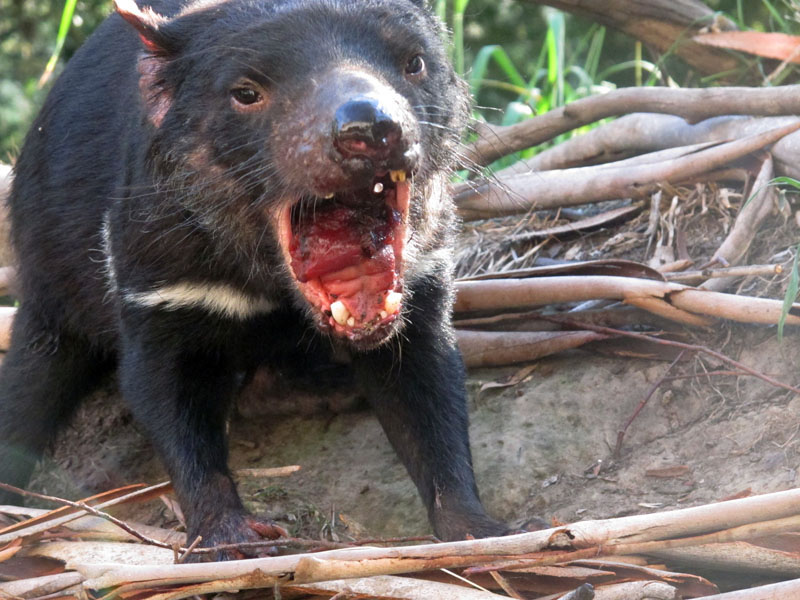Saving devils, in a single disease-free corner of Tasmania
TASMAN PENINSULA: Drive over one narrow isthmus in Tasmania, and then another, and you'll reach the last place on Earth where wild Tasmanian devils live apart from a contagious cancer that threatens the fearsome marsupials' existence. Conservationists are doing everything they can to keep it that way.
Devil-proof barriers, flashing roadside alarms and infrared cameras are protecting the species from their two greatest threats: cancer and cars. There are even plans for a sort of trap door that would keep diseased devils from crossing a bridge to reach the Tasman Peninsula, on the east coast of the Australian island-state.
"Saving the wild devils on the Tasman Peninsula is the Holy Grail of the whole thing — can we save a natural, wild population of devils and isolate them?" said John Hamilton, a major partner in the Peninsula Devil Conservation Project. "And pretty much we have so far."
The muscle-bound, lumbering, bear-like predator-scavenger with a ferocious growl — the inspiration for the Warner Bros. cartoon character Taz — is endangered because of a mysterious disease that has slashed its numbers in Tasmania's wilderness by as much as 90 percent since it was discovered two decades ago.
The road connecting the mainland with Forestier and Tasman is busy because of one of Tasmania's biggest tourist attractions: the sandstone ruins of a 19th-century British prison at Port Arthur, a small Tasman town.
The isolation that has protected the devils from disease also made the peninsula an ideal place to contain convicts. During the convict era, Eaglehawk Neck was better known as the Dog Line, where nine savage dogs tethered at regular intervals were enough to ensure that few convicts escaped.
Efforts to keep devils on the right side of the isthmus, and away from cars, are decidedly more humane and high-tech.
East Bay Neck is largely isolated by a devil-proof fence, and cameras monitor any potentially diseased devils that might pass.
In some areas, roadside electronic posts sound an alarm and flash blue and yellow strobe lights when they detect headlights, frightening wildlife away. The virtual fences, known locally as Night Owls, were initially developed by Austrian company iPTE Traffic Solutions to keep deer out of traffic, but also protect Australian native fauna.
The government and charity-funded Save the Tasmanian Devil Program, which oversees the Tasman project, is devising a devil-proof barrier on the road bridge over a canal at East Bay Neck.
Hamilton said a team is testing a road grid set on rollers designed for the bridge. If a devil steps on the unstable grid, it would be tipped into a pit and could only exit through a tunnel to the side of the bridge it came from.
"It hasn't yet been perfected. Quite a lot of models have been tried," Hamilton said. "But there will be some tricky method to prevent devils passing."
Conservationists' success in the Tasman region is a rare piece of good news in the grim story of the cancer known as Devil Facial Tumor Disease.
Devils actually suffer from two forms of contagious cancer. The second was discovered last year and also is absent among the Tasman population. Only two other forms of contagious cancer have been found in any species; one affects dogs, the other soft-shell clams.
Initially scientists hoped that the spread of the disease would slow as devil numbers thinned because there would be fewer animals squabbling over carcasses.
But zoologist Menna Jones, whose University of Tasmania team was among the first scientists to identify the cancer, now believes that most of the transmission happens during ferocious mating. The male uses his powerful jaws to clamp his mate by the scruff of her neck as they copulate. Then the fighting really starts: She tries to find another mate quickly, while he tries to keep hold of her, snapping at any male rivals to give his own genes the best chance to propagate.
A major hope for the wild devil is the quest for a vaccine. Scientists released 19 immunized devils into a northern Tasmanian national park where the disease exists in September, and 18 of those had produced immune responses to the disease. However, even if the vaccine works, that protection will not pass to offspring.
Jones welcomed the Tasman Peninsula initiative as part of a multipronged approach to managing the threat to the species, but noted that it could mean two very different types of wild devils emerge in the future.
"What we're finding in the wild is that devils are not going extinct and we are getting indications of rapid evolution," Jones said, referring to evidence of natural resistance to the disease and of changing biting behavior.
"At some point in the future if devils in the wild population start to recovery, they're going to be different from the ones that are in the insurance population, which would still be highly vulnerable and highly susceptible to the disease," she added.
That would mean the Tasman devils would still need to be separated from the rest of Tasmania. And if populations elsewhere falter, saving them from traffic will be all the more important.
Hamilton said no devil has been killed by a car in Tasman since the first 2 kilometers (1.2 miles) of Night Owls were installed in areas most prone to roadkill. He has raised 20,000 Australian dollars ($14,500) through his Tasman wildlife park, Tasmanian Devil Unzoo, for another 3 kilometers (2 miles), and eventually wants the virtual fencing to extend the entire 38 kilometers (24 miles) from Dunalley to Port Arthur.
"Every single devil down here is incredibly precious," Hamilton said. "These are the last isolated, healthy, safe, wild devils on the planet."






